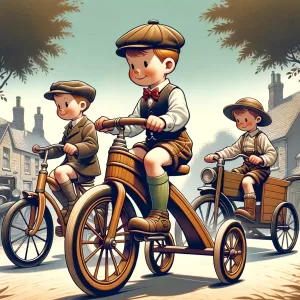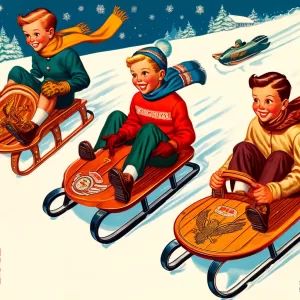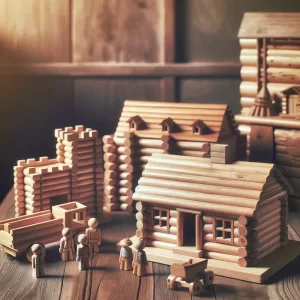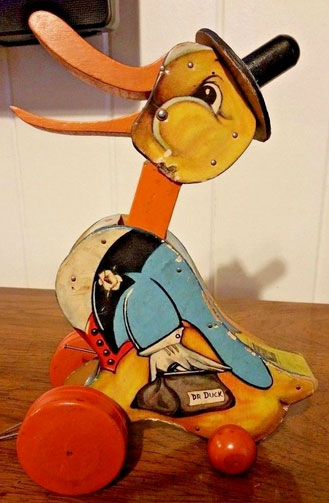Contributer
Vintage Wooden Tricycles
 Vintage Wooden Tricycles: Pedaling Back in Time
Vintage Wooden Tricycles: Pedaling Back in Time
Welcome back to VintageWoodToys.com! Today, we journey back to the charming era of vintage wooden tricycles, beloved playthings that have pedaled their way through generations.
The Charm of Wooden Tricycles
Wooden tricycles hold a special place in the pantheon of children’s toys. Known for their sturdiness and timeless design, these tricycles were not just toys but also tools that helped children develop physical coordination and balance. Crafted from wood, with metal components and rubber wheels, these tricycles are a testament to the craftsmanship of earlier times.
Evolution of Design
The design of wooden tricycles has evolved over the decades, reflecting changes in aesthetic preferences and manufacturing technologies. Early models from the late 19th and early 20th centuries often featured intricate woodwork and were sometimes even hand-painted or varnished to highlight the wood’s natural beauty.
Iconic Models and Their Legacy
Several models of vintage wooden tricycles have become iconic over the years, cherished for their craftsmanship and nostalgic value:
| Model Name | Description | Years Sold | Price When Sold | Current Estimated Price as Collectible |
|---|---|---|---|---|
| The Classic Racer | Streamlined design known for its durability, popular in the 1920s-1930s. | 1920s-1930s | $2.50 | $120 |
| The Retro Flyer | Distinctive curved handlebar and wide seat, staple of the 1950s. | 1950s | $3.00 | $150 |
| The Pioneer Trike | Rugged construction with a chunky frame, popular in rural areas during the 1940s. | 1940s | $3.50 | $130 |
These models not only provided joy but also offered a physical form of play that encouraged exploration and independence among young riders.
Collecting and Preserving
Today, vintage wooden tricycles are sought after by collectors and enthusiasts who appreciate their historical significance and aesthetic appeal. Restoring these tricycles can be a labor of love, as enthusiasts often seek to preserve or recreate the original finishes and components.
Conclusion: A Ride Through History
Vintage wooden tricycles are more than just toys; they are artifacts of a bygone era, evoking memories of youthful adventures and simpler times. As we pedal back in time with each article, we uncover the stories these tricycles carry and the timeless joy they continue to bring.
Join us next time on VintageWoodToys.com as we continue to explore the rich history of vintage toys and the stories they tell.
Vintage Kouvalias Pull Toys
 Vintage Kouvalias Pull Toys: The Art of Playful Movements
Vintage Kouvalias Pull Toys: The Art of Playful Movements
Welcome back to VintageWoodToys.com, where we explore the charm and history of cherished playthings. Today, we delve into the delightful world of Kouvalias pull toys, a staple of childhood for many and a celebrated piece of toy craftsmanship.
The Kouvalias Legacy
Originating from Greece in the mid-20th century, Kouvalias toys are renowned for their vivid colors, exceptional quality, and the distinctive clacking sound they make when pulled. These toys were designed not just for play but also to stimulate children’s sensory development and fine motor skills.
Design and Craftsmanship
Kouvalias pull toys are distinguished by their use of bright, non-toxic paints and natural wood. Each toy features elements that spin, bob, and weave as they move, creating a mesmerizing display that captivates and delights. The craftsmanship is meticulous, reflecting the company’s commitment to creating durable and safe toys that could be passed down through generations.
Iconic Kouvalias Toys
Among the most beloved Kouvalias pull toys are:
| Toy Title | Description | Years Sold | Price When Sold | Current Estimated Price as Collectible |
|---|---|---|---|---|
| The Spinning Top | Brightly colored top with intricate patterns that spin mesmerizingly. | 1960s-present | $3.50 | $50 |
| The Wobbly Duck | A charming duck that bobs and waddles as it’s pulled along. | 1970s-present | $4.00 | $65 |
| The Caterpillar | A segmented caterpillar with a body that twists and turns, showing a rainbow of colors. | 1980s-present | $5.00 | $80 |
These toys not only brought joy but also helped children develop coordination and cognitive skills through play.
Collectible and Cherished
Kouvalias toys have become highly collectible due to their unique designs and nostalgic value. Collectors and enthusiasts seek out these toys, often restoring them to preserve their vibrant colors and mechanical movements.
Conclusion: A Legacy of Joy and Ingenuity
Kouvalias pull toys represent a blend of artistic expression and playful learning. They remind us of the simplicity and joy of childhood play, and their lasting appeal ensures they remain cherished by collectors and new generations alike.
Join us next time on VintageWoodToys.com as we continue to uncover the stories behind the toys that have brought endless hours of joy and learning to children around the world.
Vintage Flexible Flyer Sleds
 Vintage Flexible Flyer Sleds: Gliding Through History
Vintage Flexible Flyer Sleds: Gliding Through History
Welcome back to VintageWoodToys.com! Today, we slide into the history of the Flexible Flyer, the iconic sled that has brought winter joy to countless generations.
The Origins of Flexible Flyer
The Flexible Flyer sled was first introduced in 1889 by Samuel Leeds Allen, a farm equipment manufacturer looking to keep his workforce employed during the winter months. His innovative design featured a steel runner sled, which not only provided durability but also offered unprecedented control and speed, making it a staple of wintertime fun.
The Design That Defined Sledding
What set Flexible Flyers apart was their patented steering mechanism. Riders could steer the sled using their feet, pushing on the crossbar to guide the sled left or right. This ability to steer made the Flexible Flyer the sled of choice for thrill-seekers and has remained virtually unchanged even today due to its effective simplicity.
Memorable Models and Collectible Pieces
Over the decades, several models of Flexible Flyer sleds have become highly collectible, including:
| Model Name | Description | Years Sold | Cost When New | Current Estimated Value |
|---|---|---|---|---|
| Airline Series | Sleek design, superior speed, ideal for smooth and fast downhill runs. | 1930s-1950s | $5.00 | $150 |
| Racer Series | Longer and narrower build, designed for performance and speed racing. | 1920s-1940s | $7.50 | $200 |
| Eagle Series | Elaborate eagle design on the top, known for its decorative appeal. | 1950s-1970s | $10.00 | $250 |
These models are cherished not only for their nostalgic appeal but also for their craftsmanship and the memories they hold of snowy adventures.
The Legacy Continues
The Flexible Flyer has become more than just a sled; it’s a symbol of joyous winter days and a reminder of childhood fun. It remains popular among collectors and enthusiasts who appreciate its historical significance and the simple pleasure it offers.
Conclusion: A Winter Wonder
The story of the Flexible Flyer is a testament to innovation and the joy of simple pleasures. As we look back on the snowy trails blazed by generations before us, we celebrate these sleds not just as toys but as cherished pieces of winter history.
Vintage Lincoln Logs
 Vintage Lincoln Logs: Building Memories One Log at a Time
Vintage Lincoln Logs: Building Memories One Log at a Time
Welcome back to VintageWoodToys.com, where we delve into the rich tapestry of childhood playthings. Today, we’re exploring the classic charm of Lincoln Logs, the timeless toy that has captivated children and adults alike for generations.
A Brief History
Lincoln Logs were invented in 1916 by John Lloyd Wright, son of the famous architect Frank Lloyd Wright. Inspired by his father’s design principles and the interlocking beams used in the Imperial Hotel in Tokyo, John created a toy that encouraged creativity and problem-solving. Originally marketed with the slogan “Interesting playthings typifying the spirit of America,” Lincoln Logs have become a beloved part of American toy history.
The Design and Appeal
Characteristic for their notched, round logs, Lincoln Logs are designed to interlock easily, allowing builders to create sturdy structures ranging from simple cabins to complex fortresses. Made primarily of wood, these logs have a tactile feel that stimulates fine motor skills and sensory experiences. Over the years, sets have included various accessories like figures, animals, and additional building components, expanding the creative possibilities.
Iconic Sets and Collectibles
Lincoln Logs have seen various memorable sets over the years. Here’s a chart showcasing some iconic sets, detailing when they were sold, their original cost, and their estimated current value for collectors:
| Set Name | Sold From | Original Cost | Current Estimated Value |
|---|---|---|---|
| Frontier Junction | 1963 | $4.99 | $80 |
| Meetinghouse | 1970 | $6.50 | $120 |
| Fort Hudson | 1985 | $12.00 | $150 |
| Pioneer Peak | 1993 | $18.00 | $200 |
| Collector’s Edition Village | 2005 | $50.00 | $300 |
Some of the most sought-after Lincoln Logs sets include the ‘Frontier Junction’ and ‘Meetinghouse’. Collectors also prize vintage sets from the mid-20th century for their rarity and the quality of wood used. Each set tells a story of the era it was produced in, reflecting changes in manufacturing processes and societal tastes.
Educational Value
Beyond their nostalgic appeal, Lincoln Logs offer educational benefits, teaching principles of construction, balance, and design. They serve as an early introduction to the concepts of architecture and engineering, encouraging children to think spatially and plan strategically as they build.
Conclusion: A Legacy of Joy
Lincoln Logs are more than just toys; they are gateways to imagination and creativity. Whether you’re rediscovering your childhood through these classic toys or sharing them with new generations, Lincoln Logs offer a unique blend of educational value and nostalgic charm.
Join us next time as we continue to explore the treasures of yesteryear at VintageWoodToys.com, where every toy has a story and every story is a memory carved in wood.
Vintage Fisher Price Pull Toys

Dr Doodle 1932
Vintage Fisher-Price Pull Toys: A Journey Through Time
Introduction to Fisher-Price
Founded in 1930 by Herman Fisher, Irving Price, and Helen Schelle, Fisher-Price embarked on a mission to create toys that “appeal to the imagination, that do something new and surprising and funny.” With a commitment to making play a more enriching and enjoyable experience for children, Fisher-Price quickly established itself as a leader in the toy industry, introducing families around the world to toys that were not only fun but also educational.
The Advent of Pull Toys
Among the company’s earliest successes were its pull toys, a line that became synonymous with Fisher-Price’s brand of creativity and quality. The Snoopy Sniffer, released in 1938, and the Chatter Telephone, introduced in 1961, were more than mere playthings; they were companions that brought to life the magic of play through movement and sound, engaging children in a way that toys had not done before.
Design and Features
What set Fisher-Price pull toys apart were their distinctive design elements. Made to endure, these toys were crafted from wood and later durable plastic, featuring bright, engaging colors and characters that delighted children. The incorporation of sounds—bells, chimes, and later, electronic noises—along with the movement, added layers of engagement, making each pull toy an adventure in itself.
Iconic Models
Icons like the Little Snoopy, the Buzzy Bee, and the Chatter Telephone became staples in homes across the globe. Each model had its own charm—whether it was Little Snoopy’s wagging tail and floppy ears or the Buzzy Bee’s fluttering wings and buzzing sound. These toys were more than just objects of play; they were a child’s first friends, sparking joy and fostering a sense of curiosity.
Collectability and Value
Today, vintage Fisher-Price pull toys are treasured not just for their sentimental value but also as collectible items. Factors like rarity, condition, and original packaging play significant roles in determining their market value. Collectors often seek out limited editions or toys that were only in production for a short period, making them rare gems in the world of vintage toys.
| Toy Name | Year Introduced | Approx. Collector’s Value ($) |
|---|---|---|
| Snoopy Sniffer | 1938 | 100 |
| Chatter Telephone | 1961 | 50 |
| Buzzy Bee | 1950 | 75 |
| Mickey Mouse Choo-Choo | 1936 | 200 |
| Donald Duck Choo-Choo | 1934 | 250 |
| Looky Fire Truck | 1952 | 150 |
| Teddy Zilo | 1950 | 125 |
| Molly Moo Cow | 1955 | 90 |
These values are approximate and can vary based on the toy’s condition, rarity, and demand among collectors.
Impact and Legacy
The legacy of Fisher-Price pull toys extends beyond their collectibility. They represent a time when play was simpler yet deeply imaginative. For many, these toys are a link to childhood, a tangible connection to joy and wonder. The impact of these toys is also evident in the company’s enduring popularity and the continued appreciation for toys that are both fun and educational.
Preservation and Restoration
For collectors, preserving the condition of these toys is paramount. Techniques include gentle cleaning, proper storage away from direct sunlight, and, for the more dedicated enthusiast, professional restoration. These efforts not only maintain the toys’ aesthetic appeal but also their historical and monetary value.
Conclusion
Vintage Fisher-Price pull toys hold a special place in the history of play. They embody the innovation and quality that Fisher-Price has stood for over the decades. As we look back on these cherished toys, we are reminded of the joy they brought to our lives and the simple pleasures of childhood. For collectors, they represent a piece of history, a testament to the enduring power of play. Fisher-Price pull toys are not just toys; they are memories carved in wood and plastic, echoing the laughter of generations.